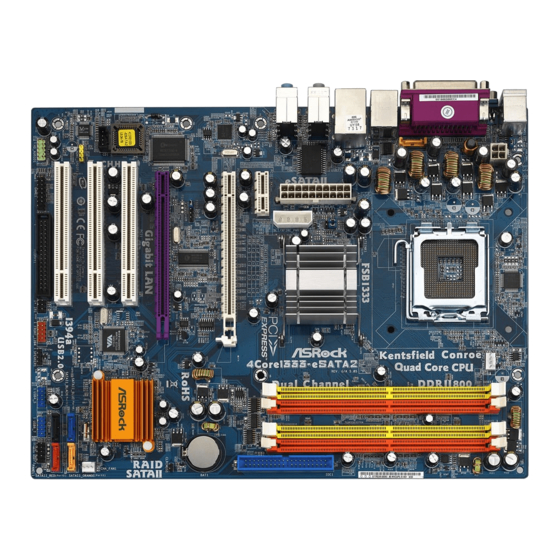Table of Contents
Advertisement
Quick Links
Guide to SATA Hard Disks
Installation and RAID Configuration
1.
Guide to SATA Hard Disks Installation ............................ 2
1.1
Serial ATA (SATA) Hard Disks Installation ............... 2
2.
Guide to RAID Configurations ......................................... 3
2.1
Introduction of RAID ............................................... 3
2.2
RAID Configuration Precautions ............................ 5
2.3
64-bit With RAID Functions ........................ 6
2.4
Setting the BIOS RAID Items ................................ 11
2.5
Configuring the Intel RAID BIOS ........................... 11
2.6
Deleting RAID Volume .......................................... 15
®
1
TM
/
Advertisement
Table of Contents

Summary of Contents for ASROCK 4CORE1333-ESATA2
-
Page 1: Table Of Contents
Guide to SATA Hard Disks Installation and RAID Configuration Guide to SATA Hard Disks Installation ......2 Serial ATA (SATA) Hard Disks Installation ....2 Guide to RAID Configurations ......... 3 Introduction of RAID ..........3 RAID Configuration Precautions ......5 ®... -
Page 2: Guide To Sata Hard Disks Installation
Matrix Storage. Intel ICH7R southbridge chipset supports Serial ATA (SATA) hard disks with RAID functions, including RAID 0, RAID 1, RAID 10, RAID 5, and Intel Matrix Storage. Please read the RAID configurations in this guide carefully according to the Intel southbridge chipset that your motherboard adopts. -
Page 3: Guide To Raid Configurations
RAID 10 / RAID 5 function with four independent Serial ATA (SATA) channels. This section will introduce the basic knowledge of RAID, and the guide to configure RAID 0 / RAID 1/ Intel Matrix Storage / RAID 10 / RAID 5 settings. - Page 4 RAID 0 and RAID 1 set using only two identical hard disk drives. The Intel Matrix Storage technology creates two partitions on each hard disk drive to create a virtual RAID 0 and RAID 1 sets. This technology also allows you to change the hard disk drive partition size without losing any data.
-
Page 5: Raid Configuration Precautions
WARNING!! Please backup your data first before you create RAID functions. In the process you create RAID, the system will ask if you want to “Clear Disk Data” or not. It is recommended to select “Yes”, and then your future... -
Page 6: Installing Windows 2000 / Xp / Xp 64-Bit / Vista
Please select CD-ROM as the boot device. C. When you see the message on the screen, “Do you want to generate Serial ATA driver diskette [YN]?”, press <Y>. D. Then you will see these messages, Please insert a diskette into the floppy drive. - Page 7 RAID Configuration”, which is located in the folder at the following path: .. \ RAID Installation Guide and the document in the support CD, “Guide to Intel Matrix Storage Manager”, which is located in the folder at the following path: .. \ Intel Matrix Storage Manager Information If you want to use “Intel Matrix Storage Manager”...
- Page 8 1. Physically attach one additional SATA / SATAII hard drive to the SATAII port not being used. Note the serial number of the hard drive already in the system; you will use this to select it as the source hard drive when initiating the migration.
-
Page 9: Raid Functions
Configuration”, which is located in the folder at the following path: .. \ RAID Installation Guide and the document in the support CD, “Guide to Intel Matrix Storage Manager”, which is located in the folder at the following path: .. \ Intel Matrix Storage Manager Information... - Page 10 2. If you install Windows Vista / Vista 64-bit OS, please do not create RAID 0 and RAID 5 or RAID 1 and RAID 5 at the same time under BIOS environment. It is recommended to create RAID array one by one.
-
Page 11: Setting The Bios Raid Items
2.4 Setting the BIOS RAID Items After installing the hard disk drives, please set the necessary RAID items in the BIOS before setting your RAID configuration. Boot your system, and press <F2> key to enter BIOS setup utility. Highlight Advanced and press <Enter>, then the main interface of BIOS setup utility will appear. - Page 12 1-16 letters for your RAID volume then press <Enter>. Volume0 Use the up or down arrow keys to select your desired RAID Level. You may select RAID0 (Stripe), RAID1 (Mirror), RAID 5, RAID 10, or Matrix Storage for your RAID level. Press <Enter>, and then you can...
- Page 13 Volume0 If you selected RAID 0 (Stripe), use the up or down arrow keys to select the stripe size for your RAID 0 array then press <Enter>.The available values range from 8 KB to 128 KB. The default selection is 128 KB.
- Page 14 Volume0 Press <Enter> under the Create Volume item. The utility prompts a confirmation message as below. Volume0 Press <Y> to complete the setup of RAID. After the completion, you will see the detailed information about the RAID that you set up.
-
Page 15: Deleting Raid Volume
Please note that you are only allowed to create one RAID partition at a time under BIOS RAID environment. If you want to create extra RAID partition, please use the RAID utility under Windows environment to configure RAID functions after you install OS.













